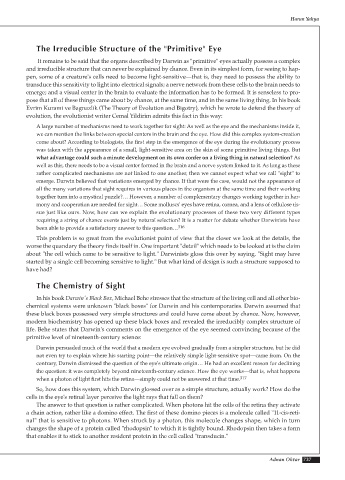Page 739 - Atlas of Creation Volume 2
P. 739
Harun Yahya
The Irreducible Structure of the "Primitive" Eye
It remains to be said that the organs described by Darwin as "primitive" eyes actually possess a complex
and irreducible structure that can never be explained by chance. Even in its simplest form, for seeing to hap-
pen, some of a creature's cells need to become light-sensitive—that is, they need to possess the ability to
transduce this sensitivity to light into electrical signals; a nerve network from these cells to the brain needs to
emerge; and a visual center in the brain to evaluate the information has to be formed. It is senseless to pro-
pose that all of these things came about by chance, at the same time, and in the same living thing. In his book
Evrim Kurami ve Bagnazlik (The Theory of Evolution and Bigotry), which he wrote to defend the theory of
evolution, the evolutionist writer Cemal Yildirim admits this fact in this way:
A large number of mechanisms need to work together for sight: As well as the eye and the mechanisms inside it,
we can mention the links between special centers in the brain and the eye. How did this complex system-creation
come about? According to biologists, the first step in the emergence of the eye during the evolutionary process
was taken with the appearance of a small, light-sensitive area on the skin of some primitive living things. But
what advantage could such a minute development on its own confer on a living thing in natural selection? As
well as this, there needs to be a visual center formed in the brain and a nerve system linked to it. As long as these
rather complicated mechanisms are not linked to one another, then we cannot expect what we call "sight" to
emerge. Darwin believed that variations emerged by chance. If that were the case, would not the appearance of
all the many variations that sight requires in various places in the organism at the same time and their working
together turn into a mystical puzzle?… However, a number of complementary changes working together in har-
mony and cooperation are needed for sight… Some molluscs' eyes have retina, cornea, and a lens of cellulose tis-
sue just like ours. Now, how can we explain the evolutionary processes of these two very different types
requiring a string of chance events just by natural selection? It is a matter for debate whether Darwinists have
been able to provide a satisfactory answer to this question… 316
This problem is so great from the evolutionist point of view that the closer we look at the details, the
worse the quandary the theory finds itself in. One important "detail" which needs to be looked at is the claim
about "the cell which came to be sensitive to light." Darwinists gloss this over by saying, "Sight may have
started by a single cell becoming sensitive to light." But what kind of design is such a structure supposed to
have had?
The Chemistry of Sight
In his book Darwin's Black Box, Michael Behe stresses that the structure of the living cell and all other bio-
chemical systems were unknown "black boxes" for Darwin and his contemporaries. Darwin assumed that
these black boxes possessed very simple structures and could have come about by chance. Now, however,
modern biochemistry has opened up these black boxes and revealed the irreducibly complex structure of
life. Behe states that Darwin's comments on the emergence of the eye seemed convincing because of the
primitive level of nineteenth-century science:
Darwin persuaded much of the world that a modern eye evolved gradually from a simpler structure, but he did
not even try to explain where his starting point—the relatively simple light-sensitive spot—came from. On the
contrary, Darwin dismissed the question of the eye's ultimate origin… He had an excellent reason for declining
the question: it was completely beyond nineteenth-century science. How the eye works—that is, what happens
when a photon of light first hits the retina—simply could not be answered at that time. 317
So, how does this system, which Darwin glossed over as a simple structure, actually work? How do the
cells in the eye's retinal layer perceive the light rays that fall on them?
The answer to that question is rather complicated. When photons hit the cells of the retina they activate
a chain action, rather like a domino effect. The first of these domino pieces is a molecule called "11-cis-reti-
nal" that is sensitive to photons. When struck by a photon, this molecule changes shape, which in turn
changes the shape of a protein called "rhodopsin" to which it is tightly bound. Rhodopsin then takes a form
that enables it to stick to another resident protein in the cell called "transducin."
Adnan Oktar 737

